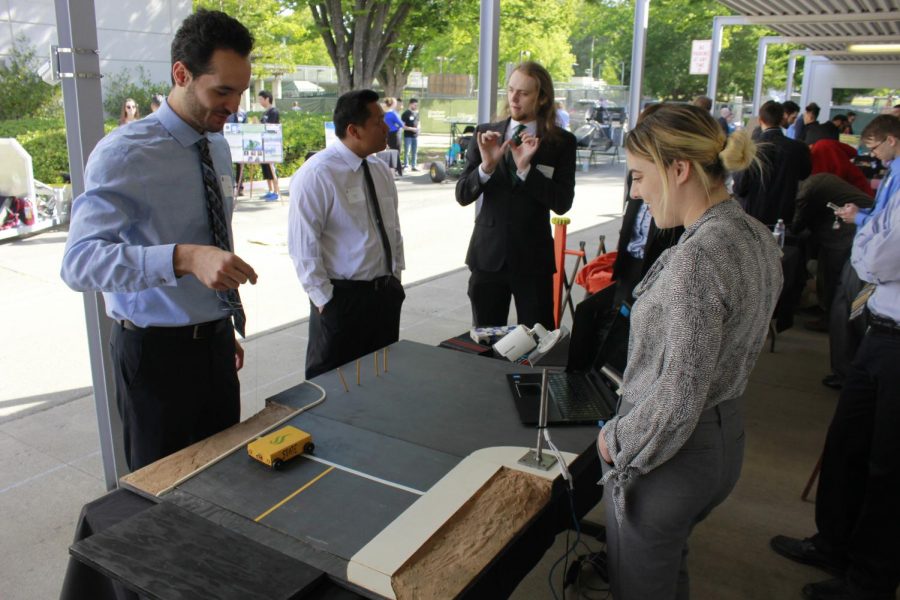Parking tracker created by students needs OK from UTAPS
Getting the OK from UTAPS is final step
Thomas Frey – The State Hornet
Marco Bonanni (left) and Lauren Rice (right) show how the camera tracks cars through the camera and on to the computer display with their mini-model at the Senior Design Showcase on May 11 in the Santa Clara Hall Breezeway at Sacramento State.
May 15, 2018
Parking Lots 9 and 10 could utilize a parking tracker, created by five mechanical engineering students, in the upcoming fall semester at Sacramento State.
The group has worked on this project since September and has developed a code that will tell students through the Sac State parking app how many spaces are available in those lots.
“I think everyone can agree that Sac State’s parking is not ideal,” said group member Lauren Rice. “I think parking struggles is a main reason people are late to class. We want to make it a little bit easier.”
Rice and fellow group members Marco Bonanni, Timothy Hagen, Caitlin Planchard and Kevin Staebler went through a lot of trial and error before getting everything set, according to Staebler.
RELATED: Mechanical engineering majors developing parking tracker
The group said that one of its biggest struggles was figuring out how it is going to power the cameras that help to track the cars entering and exiting.
“Initially what we were gonna do is have outlets that would power ethernet cables that would also power the cameras,” Hagen said. “The issue with those is that they’d be really costly and timely. What we ended up doing was switching to a Wifi based camera.”
Those will be powered by solar panels. Between the two lots that combine to hold 1,170 parking spots, their will be a total of four solar panels which cost about $1,000 each, according to Rice.
The group members have bought one solar panel so far and are waiting to buy the rest until they hear from client University Transportation and Parking Services (UTAPS).
Rice said they are just waiting for UTAPS to get back to them and said UTAPS hasn’t been responding quickly throughout this whole project.
“They are very slow in getting back to us and it is very hard to get things going,” Rice said. “We email them back almost the day of when they email us, but it takes them a week to send something back to us and say what the plan is for stuff to do.
“We have everything set up for them. Now it’s just, give us the go ahead, let us order the parts because we have one solar panel right now, but we don’t want to buy all of them because that is really expensive on our part, and if they’re not gonna tell us what’s going to happen, we don’t want that to come out of our pockets.”
RELATED: Senior gymnast’s flair on floor leads to national following
With the one solar panel and cameras, the group was able to experiment and figure it out.
They set up their equipment in a parking lot and worked until they had a system that would send information to their program instantly that said how many cars were in the lot. Hagen said that even if it was dark or their was fog, that the system would still work.
Hagen also said that he hopes they can have this ready by the end of the summer. Rice said they will most likely stick around until this is finished, even though they are all graduating this month.
When asked if they would stay until December if the project still had yet to be completed by then, Rice said they most likely would.
Once the group receives the rest of the solar panels and cameras, members said it would take a couple of hours to set everything up and calibrate the cameras.
If this is successful, Rice said the University could use this in more of its parking facilities.





























































































































